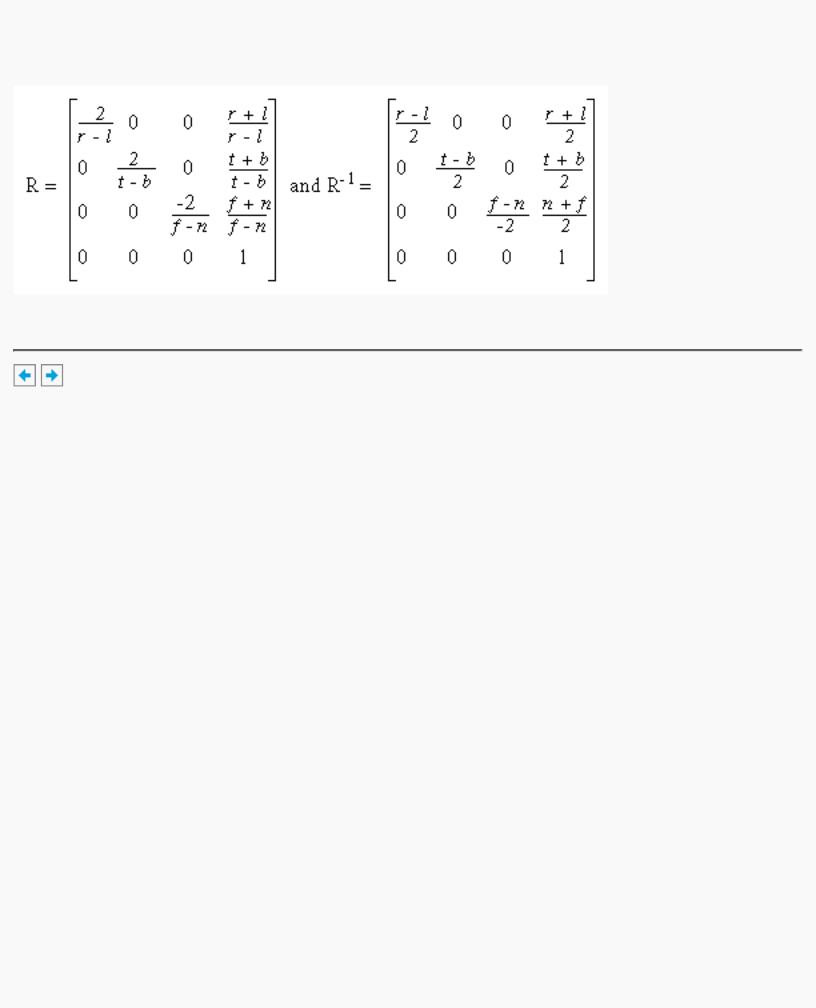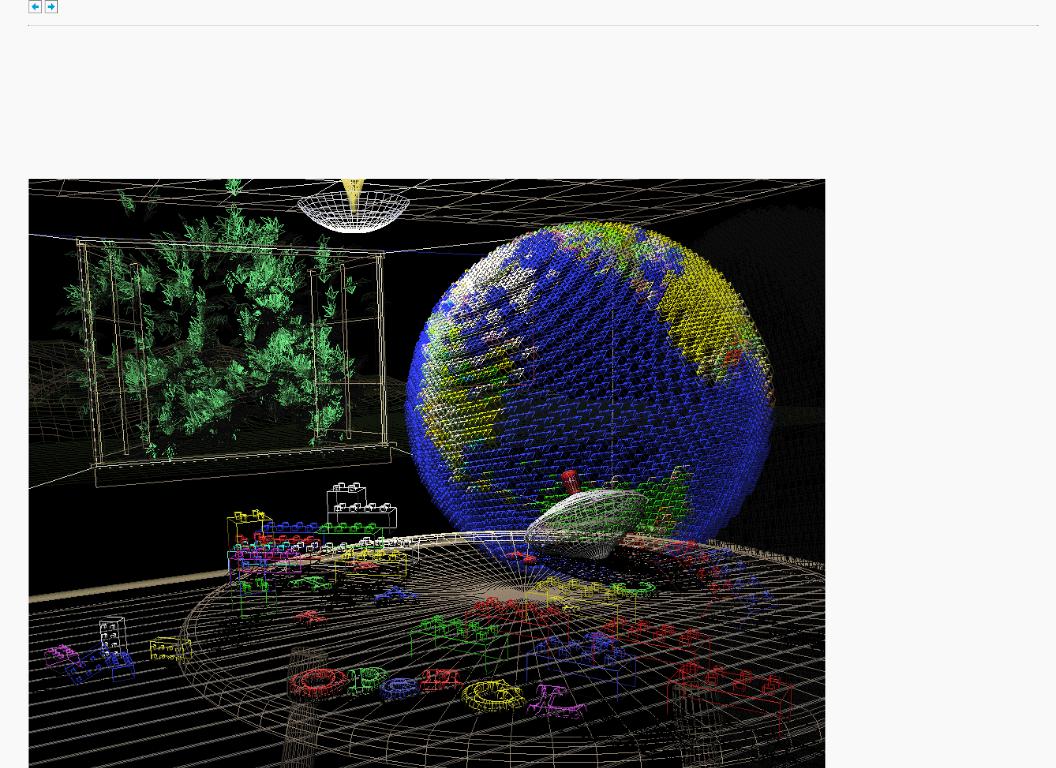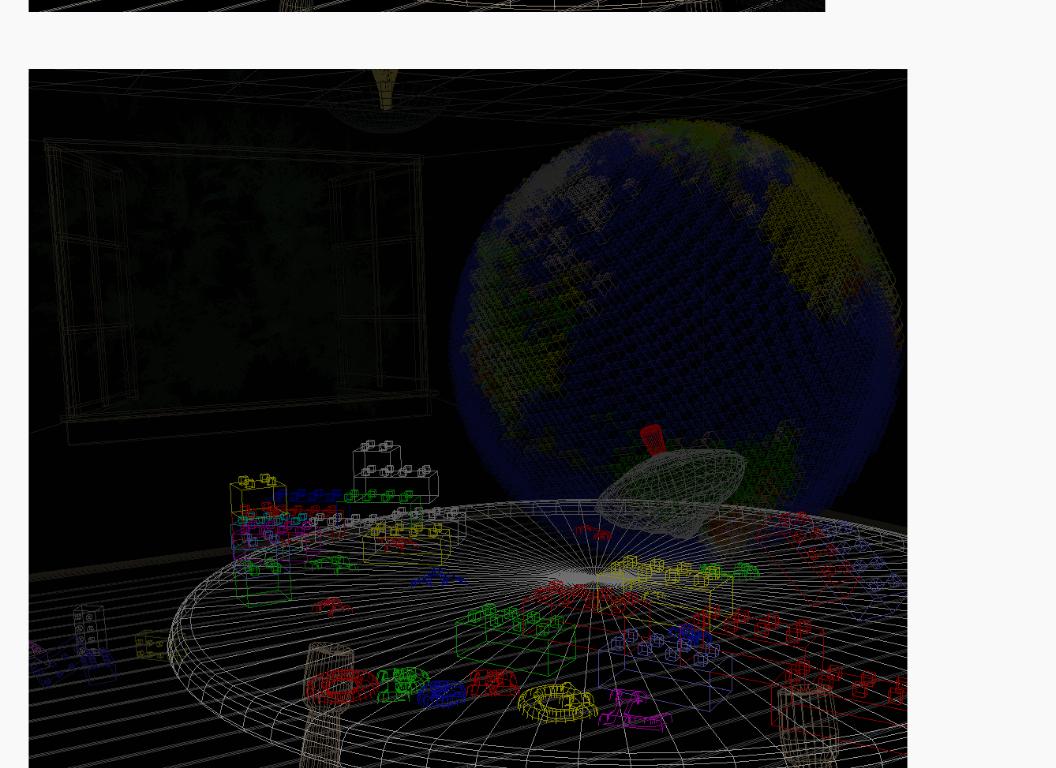
The Official Guide to Learning OpenGL, Version 1.1 (Redbook Second Edition)
.pdf
OpenGL Programming Guide (Addison-Wesley Publishing Company)
Orthographic Projection
The call glOrtho(l, r, b, t, n, f ) generates R, where
R is defined as long as l ≠ r, t ≠ b, and n ≠ f.
OpenGL Programming Guide (Addison-Wesley Publishing Company)
http://heron.cc.ukans.edu/ebt-bin/nph-dweb/dynaw...Generic__BookTextView/37451;cs=fullhtml;pt=37099 (5 of 5) [4/28/2000 9:51:52 PM]

OpenGL Programming Guide (Addison-Wesley Publishing Company)
OpenGL Programming Guide (Addison-Wesley Publishing Company)
Appendix G
Programming Tips
This appendix lists some tips and guidelines that you might find useful. Keep in mind that these tips are based on the intentions of the designers of the OpenGL, not on any experience with actual applications and implementations! This appendix has the following major sections:
●"OpenGL Correctness Tips"
●"OpenGL Performance Tips"
●"GLX Tips"
OpenGL Correctness Tips
●Perform error checking often. Call glGetError() at least once each time the scene is rendered to make certain error conditions are noticed.
●Do not count on the error behavior of an OpenGL implementation - it might change in a future release of OpenGL. For example, OpenGL 1.1 ignores matrix operations invoked between glBegin() and glEnd() commands, but a future version might not. Put another way, OpenGL error semantics may change between upward-compatible revisions.
●If you need to collapse all geometry to a single plane, use the projection matrix. If the modelview matrix is used, OpenGL features that operate in eye coordinates (such as lighting and application-defined clipping planes) might fail.
●Do not make extensive changes to a single matrix. For example, do not animate a rotation by continually calling glRotate*() with an incremental angle. Rather, use glLoadIdentity() to initialize the given matrix for each frame, then call glRotate*() with the desired complete angle for that frame.
●Count on multiple passes through a rendering database to generate the same pixel fragments only if this behavior is guaranteed by the invariance rules established for a compliant OpenGL implementation. (See Appendix H for details on the invariance rules.) Otherwise, a different set of fragments might be generated.
http://heron.cc.ukans.edu/ebt-bin/nph-dweb/dynaw...Generic__BookTextView/38018;cs=fullhtml;pt=37451 (1 of 5) [4/28/2000 9:52:34 PM]

OpenGL Programming Guide (Addison-Wesley Publishing Company)
●Do not expect errors to be reported while a display list is being defined. The commands within a display list generate errors only when the list is executed.
●Place the near frustum plane as far from the viewpoint as possible to optimize the operation of the depth buffer.
●Call glFlush() to force all previous OpenGL commands to be executed. Do not count on glGet*() or glIs*() to flush the rendering stream. Query commands flush as much of the stream as is required to return valid data but don't guarantee completing all pending rendering commands.
●Turn dithering off when rendering predithered images (for example, when glCopyPixels() is called).
●Make use of the full range of the accumulation buffer. For example, if accumulating four images, scale each by one-quarter as it's accumulated.
●If exact two-dimensional rasterization is desired, you must carefully specify both the orthographic projection and the vertices of primitives that are to be rasterized. The orthographic projection should be specified with integer coordinates, as shown in the following example:
gluOrtho2D(0, width, 0, height);
where width and height are the dimensions of the viewport. Given this projection matrix, polygon vertices and pixel image positions should be placed at integer coordinates to rasterize predictably. For example, glRecti(0, 0, 1, 1) reliably fills the lower left pixel of the viewport, and glRasterPos2i(0, 0) reliably positions an unzoomed image at the lower left of the viewport. Point vertices, line vertices, and bitmap positions should be placed at half-integer locations, however. For example, a line drawn from (x1, 0.5) to (x2, 0.5) will be reliably rendered along the bottom row of pixels into the viewport, and a point drawn at (0.5, 0.5) will reliably fill the same pixel as glRecti(0, 0, 1, 1).
An optimum compromise that allows all primitives to be specified at integer positions, while still ensuring predictable rasterization, is to translate x and y by 0.375, as shown in the following code fragment. Such a translation keeps polygon and pixel image edges safely away from the centers of pixels, while moving line vertices close enough to the pixel centers.
glViewport(0, 0, width, height); glMatrixMode(GL_PROJECTION); glLoadIdentity();
gluOrtho2D(0, width, 0, height); glMatrixMode(GL_MODELVIEW); glLoadIdentity(); glTranslatef(0.375, 0.375, 0.0);
/* render all primitives at integer positions */
●Avoid using negative w vertex coordinates and negative q texture coordinates. OpenGL might not clip such coordinates correctly and might make interpolation errors when shading primitives
http://heron.cc.ukans.edu/ebt-bin/nph-dweb/dynaw...Generic__BookTextView/38018;cs=fullhtml;pt=37451 (2 of 5) [4/28/2000 9:52:34 PM]

OpenGL Programming Guide (Addison-Wesley Publishing Company)
defined by such coordinates.
●Do not assume the precision of operations, based upon the data type of parameters to OpenGL commands. For example, if you are using glRotated(), you should not assume that geometric processing pipeline operates with double-precision floating point. It is possible that the parameters to glRotated() are converted to a different data type before processing.
OpenGL Performance Tips
●Use glColorMaterial() when only a single material property is being varied rapidly (at each vertex, for example). Use glMaterial() for infrequent changes, or when more than a single material property is being varied rapidly.
●Use glLoadIdentity() to initialize a matrix, rather than loading your own copy of the identity matrix.
●Use specific matrix calls such as glRotate*(), glTranslate*(), and glScale*() rather than composing your own rotation, translation, or scale matrices and calling glMultMatrix().
●Use query functions when your application requires just a few state values for its own computations. If your application requires several state values from the same attribute group, use glPushAttrib() and glPopAttrib() to save and restore them.
●Use display lists to encapsulate potentially expensive state changes.
●Use display lists to encapsulate the rendering calls of rigid objects that will be drawn repeatedly.
●Use texture objects to encapsulate texture data. Place all the glTexImage*() calls (including mipmaps) required to completely specify a texture and the associated glTexParameter*() calls (which set texture properties) into a texture object. Bind this texture object to select the texture.
●If the situation allows it, use gl*TexSubImage() to replace all or part of an existing texture image rather than the more costly operations of deleting and creating an entire new image.
●If your OpenGL implementation supports a high-performance working set of resident textures, try to make all your textures resident; that is, make them fit into the high-performance texture memory. If necessary, reduce the size or internal format resolution of your textures until they all fit into memory. If such a reduction creates intolerably fuzzy textured objects, you may give some textures lower priority, which will, when push comes to shove, leave them out of the working set.
●Use evaluators even for simple surface tessellations to minimize network bandwidth in client-server environments.
http://heron.cc.ukans.edu/ebt-bin/nph-dweb/dynaw...Generic__BookTextView/38018;cs=fullhtml;pt=37451 (3 of 5) [4/28/2000 9:52:34 PM]

OpenGL Programming Guide (Addison-Wesley Publishing Company)
●Provide unit-length normals if it's possible to do so, and avoid the overhead of GL_NORMALIZE. Avoid using glScale*() when doing lighting because it almost always requires that GL_NORMALIZE be enabled.
●Set glShadeModel() to GL_FLAT if smooth shading isn't required.
●Use a single glClear() call per frame if possible. Do not use glClear() to clear small subregions of the buffers; use it only for complete or near-complete clears.
●Use a single call to glBegin(GL_TRIANGLES) to draw multiple independent triangles rather than calling glBegin(GL_TRIANGLES) multiple times, or calling glBegin(GL_POLYGON). Even if only a single triangle is to be drawn, use GL_TRIANGLES rather than GL_POLYGON. Use a single call to glBegin(GL_QUADS) in the same manner rather than calling glBegin(GL_POLYGON) repeatedly. Likewise, use a single call to glBegin(GL_LINES) to draw multiple independent line segments rather than calling glBegin(GL_LINES) multiple times.
●Some OpenGL implementations benefit from storing vertex data in vertex arrays. Use of vertex arrays reduces function call overhead. Some implementations can improve performance by batch processing or reusing processed vertices.
●In general, use the vector forms of commands to pass precomputed data, and use the scalar forms of commands to pass values that are computed near call time.
●Avoid making redundant mode changes, such as setting the color to the same value between each vertex of a flat-shaded polygon.
●Be sure to disable expensive rasterization and per-fragment operations when drawing or copying images. OpenGL will even apply textures to pixel images if asked to!
●Unless absolutely needed, avoid having different front and back polygon modes.
GLX Tips
●Use glXWaitGL() rather than glFinish() to force X rendering commands to follow GL rendering commands.
●Likewise, use glXWaitX() rather than XSync() to force GL rendering commands to follow X rendering commands.
●Be careful when using glXChooseVisual(), because boolean selections are matched exactly. Since
http://heron.cc.ukans.edu/ebt-bin/nph-dweb/dynaw...Generic__BookTextView/38018;cs=fullhtml;pt=37451 (4 of 5) [4/28/2000 9:52:34 PM]

OpenGL Programming Guide (Addison-Wesley Publishing Company)
some implementations won't export visuals with all combinations of boolean capabilities, you should call glXChooseVisual() several times with different boolean values before you give up. For example, if no single-buffered visual with the required characteristics is available, check for a double-buffered visual with the same capabilities. It might be available, and it's easy to use.
OpenGL Programming Guide (Addison-Wesley Publishing Company)
http://heron.cc.ukans.edu/ebt-bin/nph-dweb/dynaw...Generic__BookTextView/38018;cs=fullhtml;pt=37451 (5 of 5) [4/28/2000 9:52:34 PM]

OpenGL Programming Guide (Addison-Wesley Publishing Company)
OpenGL Programming Guide (Addison-Wesley Publishing Company)
Appendix H
OpenGL Invariance
OpenGL is not a pixel-exact specification. It therefore doesn't guarantee an exact match between images produced by different OpenGL implementations. However, OpenGL does specify exact matches, in some cases, for images produced by the same implementation. This appendix describes the invariance rules that define these cases.
The obvious and most fundamental case is repeatability. A conforming OpenGL implementation generates the same results each time a specific sequence of commands is issued from the same initial conditions. Although such repeatability is useful for testing and verification, it's often not useful to application programmers, because it's difficult to arrange for equivalent initial conditions. For example, rendering a scene twice, the second time after swapping the front and back buffers, doesn't meet this requirement. So repeatability can't be used to guarantee a stable, double-buffered image.
A simple and useful algorithm that counts on invariant execution is erasing a line by redrawing it in the background color. This algorithm works only if rasterizing the line results in the same fragment x,y pairs being generated in both the foreground and background color cases. OpenGL requires that the coordinates of the fragments generated by rasterization be invariant with respect to framebuffer contents, which color buffers are enabled for drawing, the values of matrices other than those on the top of the matrix stacks, the scissor parameters, all writemasks, all clear values, the current color, index, normal, texture coordinates, and edge-flag values, the current raster color, raster index, and raster texture coordinates, and the material properties. It is further required that exactly the same fragments be generated, including the fragment color values, when framebuffer contents, color buffer enables, matrices other than those on the top of the matrix stacks, the scissor parameters, writemasks, or clear values differ.
OpenGL further suggests, but doesn't require, that fragment generation be invariant with respect to the matrix mode, the depths of the matrix stacks, the alpha test parameters (other than alpha test enable), the stencil parameters (other than stencil enable), the depth test parameters (other than depth test enable), the blending parameters (other than enable), the logical operation (but not logical operation enable), and the pixel-storage and pixel-transfer parameters. Because invariance with respect to several enables isn't recommended, you should use other parameters to disable functions when invariant rendering is required. For example, to render invariantly with blending enabled and disabled, set the blending parameters to GL_ONE and GL_ZERO to disable blending rather than calling glDisable(GL_BLEND). Alpha testing, stencil testing, depth testing, and the logical operation all can be disabled in this manner.
Finally, OpenGL requires that per-fragment arithmetic, such as blending and the depth test, is invariant to all OpenGL state except the state that directly defines it. For example, the only OpenGL parameters that affect how the arithmetic of blending is performed are the source and destination blend parameters and the blend enable parameter. Blending is invariant to all other state changes. This invariance holds for the scissor test, the alpha test, the stencil test, the depth test, blending, dithering, logical operations, and
http://heron.cc.ukans.edu/ebt-bin/nph-dweb/dynaw...Generic__BookTextView/38390;cs=fullhtml;pt=38018 (1 of 2) [4/28/2000 9:52:44 PM]

OpenGL Programming Guide (Addison-Wesley Publishing Company)
buffer writemasking.
As a result of all these invariance requirements, OpenGL can guarantee that images rendered into different color buffers, either simultaneously or separately using the same command sequence, are pixel identical. This holds for all the color buffers in the framebuffer or all the color buffers in an off-screen buffer, but it isn't guaranteed between the framebuffer and off-screen buffers.
OpenGL Programming Guide (Addison-Wesley Publishing Company)
http://heron.cc.ukans.edu/ebt-bin/nph-dweb/dynaw...Generic__BookTextView/38390;cs=fullhtml;pt=38018 (2 of 2) [4/28/2000 9:52:44 PM]

OpenGL Programming Guide (Addison-Wesley Publishing Company)
OpenGL Programming Guide (Addison-Wesley Publishing Company)
Appendix I
Color Plates
This appendix contains the color plates that appear in the printed version of this guide.
Plate 1
The scene from the cover of this book, with the objects rendered as wireframe models. See Chapter 2.
http://heron.cc.ukans.edu/ebt-bin/nph-dweb/dynaweb/SGI_Developer/OpenGL_PG/@Generic__BookTextView/38414;cs=fullhtml;pt=38390 (1 of 22) [4/28/2000 9:53:56 PM]

OpenGL Programming Guide (Addison-Wesley Publishing Company)
Plate 2
The same scene using fog for depth-cueing (lines further from the eye are dimmer). See Chapter 6.
http://heron.cc.ukans.edu/ebt-bin/nph-dweb/dynaweb/SGI_Developer/OpenGL_PG/@Generic__BookTextView/38414;cs=fullhtml;pt=38390 (2 of 22) [4/28/2000 9:53:56 PM]
